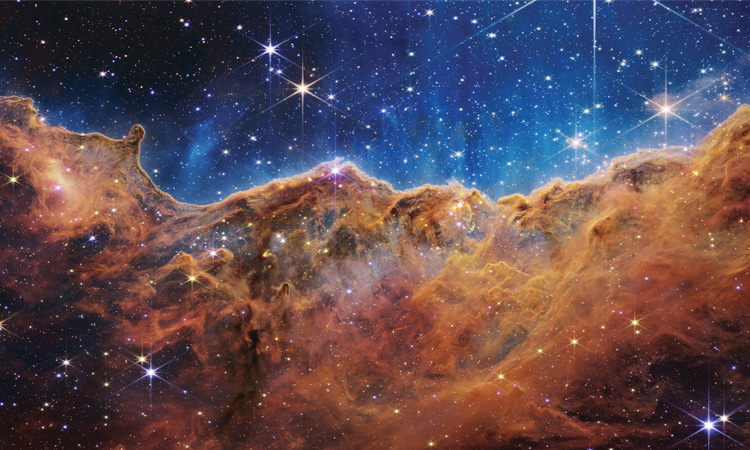 The young, star-forming region NGC 3324 in the Carina Nebula, captured in infrared light by the NIRCam instrument on the James Webb Space Telescope. The image reveals previously obscured areas of star birth. The Space Telescope Science Institute has dubbed the region the Cosmic Cliffs. [NASA, ESA, CSA, STScI]
The young, star-forming region NGC 3324 in the Carina Nebula, captured in infrared light by the NIRCam instrument on the James Webb Space Telescope. The image reveals previously obscured areas of star birth. The Space Telescope Science Institute has dubbed the region the Cosmic Cliffs. [NASA, ESA, CSA, STScI]
Call this observatory the scientific gift that unwrapped itself. As it completes its first year of scientific operations, the James Webb Space Telescope (JWST) is generating images and spectra that surprise and dazzle astrophysicists as well as the public.
Once derided as “the telescope that ate astronomy” for its numerous budget overruns and funding delays, JWST flawlessly unfolded itself shortly after its 25 December 2021 launch from French Guiana. The output from the infrared telescope, which began regular science operations in July 2022, is contributing to astronomical discoveries from the earliest galaxies to the faintest wisps of atmospheres around distant exoplanets. The versatile observatory even captured breathtaking images of distant objects in our own solar system.
With its golden mirrors, precision cameras and filter wheels shielded from solar glare, the flagship spacecraft of the astronomical community consumed the efforts of some 20,000 scientists and engineers in 14 countries for more than two decades.
Beyond capturing stunning views of stellar objects, JWST has become a cultural star in its own right. Since its first image premiered at the White House in July 2022, the telescope’s impressive pictures of planets, nebulae and galaxies have splashed across television screens, magazine covers and LED billboards above New York’s Times Square and London’s Piccadilly Circus. JWST’s logo adorns T-shirts and refrigerator magnets.
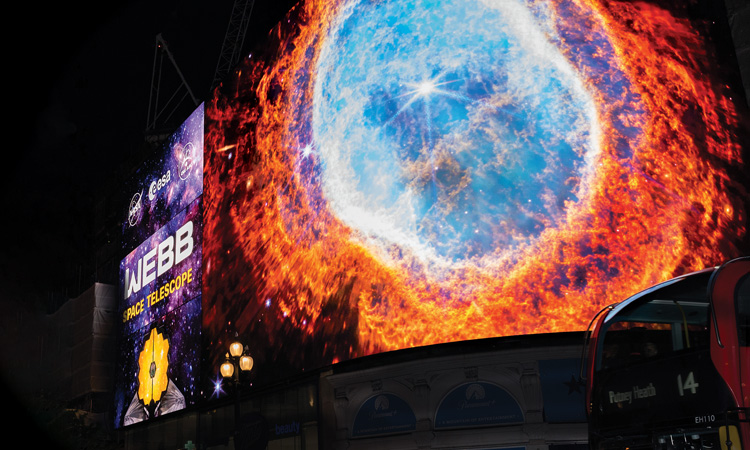 NIRCam’s image of the Southern Ring Nebula—shells of gas and dust expelled by a dying star—is displayed across Piccadilly Lights in London, UK, in July 2022. [Piccadilly Lights; CC BY 2.0]
NIRCam’s image of the Southern Ring Nebula—shells of gas and dust expelled by a dying star—is displayed across Piccadilly Lights in London, UK, in July 2022. [Piccadilly Lights; CC BY 2.0]
Part of JWST’s fame stems from the decision to release a steady stream of showcase-quality images to the public. Astronomers chose the targets of these “early-release science” observations in large part to test and demonstrate the telescope’s capabilities, both to the scientific community and to the world. Two data developers at the observatory’s operational center, the Space Telescope Science Institute (STScI), USA, skillfully bring the raw IR data into the visible spectrum and, with judicious choices of tint and contrast, create glittering portraits filled with amazing details.
Better-than-expected performance
Engineers and scientists optimized JWST to detect IR radiation that mostly cannot penetrate Earth’s atmosphere. The telescope’s 6.5-m-diameter primary mirror consists of 18 hexagonal segments made of gold-coated beryllium, instead of the traditional optical glass with a silver veneer.
Since the launch and the beginning of science operations, scientists and engineers involved with the observatory have moved from nervous tension to pride.
The observatory houses four instruments: the Near Infrared Camera (NIRCam), Near Infrared Spectrograph (NIRSpec), Mid-Infrared Instrument (MIRI) and Fine Guidance Sensor and Near Infrared Imager and Slitless Spectrograph (FGS/NIRISS). The Webb spacecraft is parked in a halo orbit around the second Lagrange point (L2), some 1.5 million km from Earth—far beyond the reach of human repair crews. Its multilayered sunshield and passive cooling design keep its mirrors and instruments in the range of 35 to 40 K, except for MIRI, which must be at 6.4 K to catch the faintest photons from the early universe.
One of the leaders of the on-orbit commissioning, JWST operations project scientist Jane Rigby of NASA’s Goddard Space Flight Center, USA, gave a triumphal plenary talk on the results at the American Astronomical Society (AAS) meeting in January 2023. Rigby characterized the observatory’s performance as “better than expected,” but that’s an understatement of the telescope’s power. Even when imaging uncluttered regions of sky during the commissioning process, scientists made unexpected discoveries.
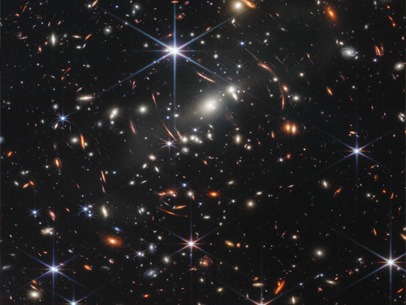 Webb’s First Deep Field—a deep IR image of the distant universe produced by NIRCam—shows thousands of galaxies in the cluster SMACS 0723, including the faintest objects ever observed in the infrared. [NASA, ESA, CSA, STScI]
Webb’s First Deep Field—a deep IR image of the distant universe produced by NIRCam—shows thousands of galaxies in the cluster SMACS 0723, including the faintest objects ever observed in the infrared. [NASA, ESA, CSA, STScI]
On 11 July 2022, NASA and STScI released the first operational science image, dubbed Webb’s First Deep Field. Scientists had pointed JWST at a tiny patch of Southern Hemisphere sky that the Hubble Space Telescope and others have photographed in search of the early universe. There they found a galaxy cluster named SMACS 0723, located some 4.6 billion light-years from Earth. After only 12.5 hours of integration, NIRCam’s image showed far more than Hubble’s famous deep field, which required weeks of observation.
Since the launch and the beginning of science operations, scientists and engineers involved with the observatory have moved from nervous tension to pride. “For me, the one change has been this sort of dawning realization of just how well we’ve built this telescope,” says Mark Clampin, NASA’s astrophysics division director. Before his 2022 promotion to the US space agency’s headquarters, Clampin spent most of his 20 years at NASA as JWST’s project scientist, first determining the requirements for a successful mission and then making sure the observatory fit the exacting specifications.
Astronomers know the dark sky “between the stars” in images is not completely devoid of light. Hubble and many ground-based telescopes have tubes to shield the optical path from stray light, but JWST has only a set of internal baffles. During commissioning, JWST scientists found less stray light than expected because the mirrors were clean and the internal baffles were working properly. Cleanliness was an obsession during integration and testing, Rigby said at the AAS meeting. That attention to detail has paid off in shorter observing times. In the mid-IR, longer than 12.5 μm, astronomers are limited by the zodiacal light and interstellar medium rather than the telescope’s thermal background emission.
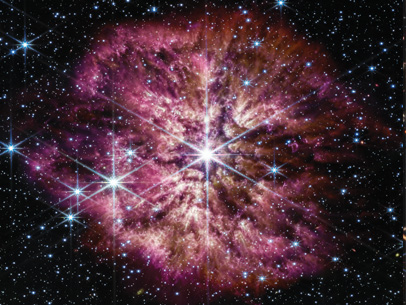 The luminous, hot star Wolf-Rayet 124 (WR 124) sits at the center of JWST’s composite image combining near-IR and mid-IR wavelengths. NIRCam balances the brightness of the star with the fainter gas and dust surrounding it, while MIRI reveals the nebula’s structure. [NASA, ESA, CSA, STScI, Webb ERO Production Team]
The luminous, hot star Wolf-Rayet 124 (WR 124) sits at the center of JWST’s composite image combining near-IR and mid-IR wavelengths. NIRCam balances the brightness of the star with the fainter gas and dust surrounding it, while MIRI reveals the nebula’s structure. [NASA, ESA, CSA, STScI, Webb ERO Production Team]
For the first yearlong cycle of JWST observations, telescope officials chose targets that would test out—and show off—the observatory’s capabilities. The Early Release Science (ERS) program showcases a smorgasbord of JWST’s primary scientific themes: the evolution of galaxies in the early universe, exoplanets, regions of stellar birth and death. And unlike other space observatory programs, JWST made ERS data open to everyone immediately.
Distant galaxies, gravitational lenses
Since NASA officials have long touted JWST’s potential to see billions of years back in time, galaxies feature prominently in the observatory’s gallery. But some of these early science results are confounding astronomers.
Cosmologists often use redshift as a shorthand way to describe the vast distances between us and distant galaxies speeding away from us. The larger the redshift, the farther away the objects (and the more distant in time as well as space).
Through the Cosmic Evolution Early Release Science Survey, or CEERS, astronomers have found hundreds of galaxies from the epoch when the universe was between 500 million and 2 billion years old. A team led by Ivo Labbé of Swinburne University of Technology, Australia, found six galaxies that, according to the standard cosmological theory and observational evidence, should not exist—the galaxies are too big and bright for their presumed age. Clearly, cosmologists will examine future JWST data for further clues.
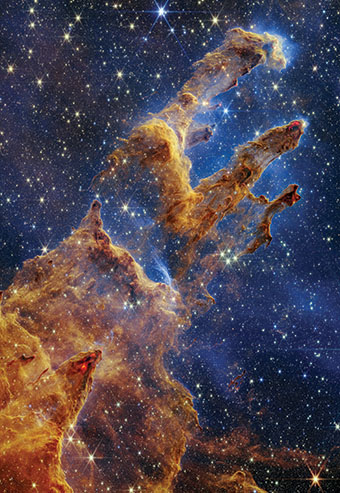 The NIRCam image of the Pillars of Creation shows new stars forming within dense clouds of gas and dust, providing a more detailed look than the 1995 Hubble image of the same region. [NASA, ESA, CSA, STScI; image processing by J. DePasquale, A.M. Koekemoer and A. Pagan (STScI)]
The NIRCam image of the Pillars of Creation shows new stars forming within dense clouds of gas and dust, providing a more detailed look than the 1995 Hubble image of the same region. [NASA, ESA, CSA, STScI; image processing by J. DePasquale, A.M. Koekemoer and A. Pagan (STScI)]
How JWST images go from raw to “wow!”
The raw image files that beam down from the James Webb Space Telescope (JWST) into the computers at the Space Telescope Science Institute (STScI), USA, are monochromatic (separate images taken with each filter wheel) and low contrast. They are arrays of recorded data about light that the human eye can never see.
So how do the data files become stunning, and often brightly colored, panoramic views? The gorgeous images released to the public via webbtelescope.org come from a two-person production team working to balance the demands of science with the imperatives of fine art.
STScI’s science visuals developers, Alyssa Pagan and Joseph DePasquale, both have bachelor’s degrees in astronomy, although Pagan earned a degree in art and design before turning to science. DePasquale previously worked on image processing for the Chandra X-ray Observatory, another NASA spacecraft collecting photons that cannot penetrate Earth’s atmosphere.
As Pagan and DePasquale explained in an online lecture hosted by STScI, they apply a nonlinear “stretch” to each image file to bring out hidden details. Then they assign colors to each wavelength range of IR light that the telescope collected—generally, the shorter wavelengths get bluer tones and the longer wavelengths are colored orange or red. Further refinements are more subjective—leaving in some of the six-pointed diffraction spikes adds “a little bit of whimsicality,” Pagan said.
To see the pair explain their step-by-step image “magic,” watch the full lecture at youtube.com/watch?v=dJX0RAyuqos.
Stellar birth-and-death cycles
Because JWST’s IR cameras can see through dust clouds that hide stellar formation and destruction at visible wavelengths, the spacecraft has brought some familiar deep-sky objects into a whole new light—for example, a star-forming region called NGC 3324. This region of the Carina Nebula, visible in the Southern Hemisphere, is an area where intense ultraviolet radiation and stellar winds from hot, young, massive stars are eroding the walls of dust in their nursery. STScI dubbed the image Cosmic Cliffs, and it has already become one of the iconic symbols of the JWST program.
On the other end of the stellar life cycle, astronomers believe some hot, giant stars toss out their outer layers of hydrogen-depleted material prior to their final core collapse and explosion as a supernova. Known as Wolf–Rayet stars, these objects are often obscured by dust clouds. JWST took a look at one such star, known as WR 124 and sitting 15,000 light-years from Earth; it photographed not only the central star, but also the roughly 30 solar masses’ worth of dust shed by the star. In STScI’s rendering, the hot dust looks like pink cotton candy.
Exoplanets and their atmospheres
JWST’s NIRSpec discovered its first exoplanet in August 2022 by measuring just two transits of the body, LHS 475 b, across its parent star. The team at Johns Hopkins University Applied Physics Laboratory, USA, had previously identified the star as a possible candidate for harboring planets. LHS 475 b is almost the same size as Earth and orbits its star in two days.
In the recent past, scientists found evidence that a few dozen exoplanets have significant atmospheres, but those observations lacked enough spectral resolving power to distinguish between molecular species. In one of JWST’s first scientific observations, an international research team led by Zafar Rustamkulov, Johns Hopkins University, studied a huge, hot exoplanet named WASP-39b with one of NIRSpec’s transmission spectroscopy modes operating between 0.5 and 5.5 μm, spanning from visible to near-IR. The scientists found strong evidence of sulfur dioxide, sodium, water vapor, carbon dioxide and carbon monoxide in WASP-39b’s atmosphere, but no methane, which could indicate potential life.
Another exoplanet, VHS 1256 b, had a dusty atmospheric surprise for its observers, led by Brittany Miles, University of Arizona, USA. In this case, the planet orbits a binary star over a 10,000-year period. Although it’s not close to its parent stars, its upper atmosphere is a toasty 1100 K. Combining NIRSpec and MIRI observations for spectral coverage all the way from 1 to 20 μm revealed swirling silicate clouds whipping around the planet, although more studies are needed to determine the size of the grains.
Even though JWST was designed to capture the faintest signals from the most distant reaches of the universe, it also has produced startlingly dramatic views of our own solar system.
Not all planets have atmospheres, however. Thomas Greene, NASA Ames Research Center, USA and his collaborators examined TRAPPIST-1, a cool dwarf star circled by seven rocky planets with masses in the range of Venus, Earth and Mars. The closest planet to the central star, TRAPPIST-1 b, gets four times the solar irradiation of Earth due to its proximity, and scientists wanted to know if such a body could hold onto a measurable atmosphere. By using what’s called secondary eclipse photometry, in which MIRI measured the change in 15-μm radiation from the planetary system as the “b” planet passed behind the star, the researchers concluded that the rocky body has little atmosphere—its temperature is 503 K, more than 100 K above models’ predictions for a world enveloped in thick gas.
New eyes on our solar system
Even though JWST was designed to capture the faintest signals from the most distant reaches of the universe, the telescope has also produced startlingly dramatic views of our own solar system.
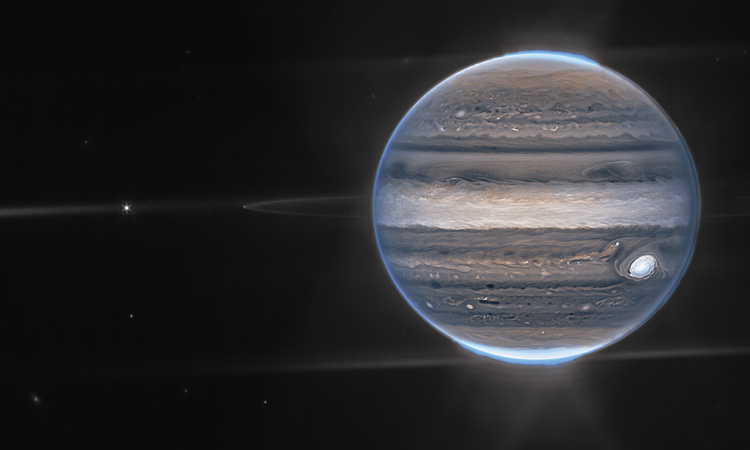 NIRCam imaged Jupiter through two filters: 2.12 μm (narrowband, shown in orange) and 3.0-3.5 μm (shown in cyan). The image captured the giant planet’s north and south auroras, diffraction from the auroras, part of the ring system, the jovian moons Amalthea and Adrastea, and a diffraction spike from the moon Io. [NASA, ESA, CSA, Jupiter ERS Team; image processing by R. Hueso (UPV/EHU) and J. Schmidt]
NIRCam imaged Jupiter through two filters: 2.12 μm (narrowband, shown in orange) and 3.0-3.5 μm (shown in cyan). The image captured the giant planet’s north and south auroras, diffraction from the auroras, part of the ring system, the jovian moons Amalthea and Adrastea, and a diffraction spike from the moon Io. [NASA, ESA, CSA, Jupiter ERS Team; image processing by R. Hueso (UPV/EHU) and J. Schmidt]
In visible light, Jupiter features creamy-looking swirls of orange, pink and red; despite its status as a gas giant, it seems almost solid. In the near-IR, however, the huge planet appears almost translucent. NIRCam’s large dynamic range captured not just the intricate details of Jupiter’s upper layers, but also some of the planet’s moons and rings and even some background stars and galaxies.
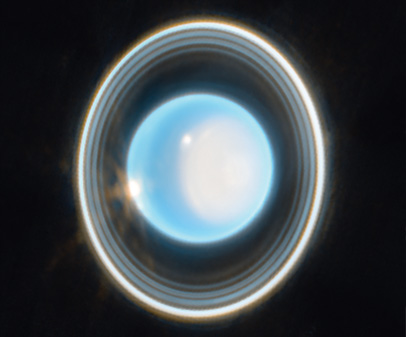 A zoomed-in image of Uranus, captured by NIRCam on 6 February 2023, reveals detailed views of the planet’s rings. [NASA, ESA, CSA, STScI; image processing by J. DePasquale (STScI)]
A zoomed-in image of Uranus, captured by NIRCam on 6 February 2023, reveals detailed views of the planet’s rings. [NASA, ESA, CSA, STScI; image processing by J. DePasquale (STScI)]
Using two filters, NIRCam photographed Uranus, which has not been seen close-up by a spacecraft since NASA’s Voyager 2 swooped by in 1986. Whereas Voyager saw a nearly featureless, pale blue ball in visible light, JWST observed a distinct cap over the planet’s wildly tilted polar region, plus two bright clouds, likely from storms. JWST also captured the rings, nearly face-on to Earth, and even the planet’s brightest moons.
Although JWST was not designed as a “rapid-response” observatory, in September 2022 it joined Hubble to capture sequential images of NASA’s Double Asteroid Redirection Test (DART) spacecraft as it intentionally smashed into a tiny asteroid named Dimorphos. According to Rigby, JWST was designed to follow objects moving across Earth’s sky no faster than 30 milliarcseconds per second—the fastest we see Mars crossing our planetary view—but with some tweaking, JWST kept up with the fast-flying collision.
 [Abbott]
[Abbott]
How a telescope improved eye surgery
Even before its launch, JWST’s optical technology found a way to improve laser eye surgery.
In the early 2000s, NASA contracted WaveFront Sciences of Albuquerque, NM, USA, to figure out the best way of measuring tiny variations in the curvature of the new observatory’s mirrors. No one wanted a repeat of the Hubble Space Telescope scenario, in which a flawed primary mirror required the on-orbit installation of a corrected optical path.
For JWST, WaveFront Sciences developed a scanning Shack–Hartmann sensor, which measured the mirrors’ curvature during the polishing process. (Traditional Shack–Hartmann wavefront sensors don’t work as well on curved surfaces like telescope mirrors.) The company spun the technology off into an eye-surgery product called the Complete Ophthalmic Analysis System, which could measure optical defects like cataracts and keratoconus 21 times faster than the competition.
Two company mergers later, the sensor technology became part of the iDesign Advanced WaveScan Studio from Abbott Medical Optics, USA. A physician could use the product to scan the curvature of a patient’s eyes and then produce a highly accurate map of the amount of correction needed from LASIK, or laser-assisted in situ keratomileusis. Johnson & Johnson Company, USA, got the wavefront-scanning technology when it acquired Abbott Medical Optics in 2017. The device, now known as the iDesign Refractive Studio, requires the patient to look into it for about 20 seconds, and the measurements are complete.
Long-term prospects and lessons learned
Because the spacecraft expended less fuel than expected on midcourse corrections during its flight to L2, JWST has enough propellant onboard to last more than 20 years of mission operations, Rigby said at the AAS meeting.
This scenario might not be too farfetched, as NASA has a decent record of extending missions far beyond their planned lifetimes. After all, Hubble is still scientifically productive after three decades—and several servicing missions—and the space agency keeps in touch with the two deep-space Voyager probes more than 40 years after their launches.
At an STScI conference, Rigby joked that, though the telescope never got hit when it was on the ground, “in space it gets hit about as often as we expected,” which is about one micrometeoroid hit per month that is impactful enough to affect JWST’s seeing. So far, only one collision has exceeded expectations: a hit to the telescope’s primary-mirror segment C3 in May 2022 increased the global wavefront error by 9 nm. About 10 such events would bring the telescope to its end-of-lifecycle wavefront error of 150 nm, Rigby explained at the AAS meeting. Future observing cycles will limit pointing into the direction from which the micrometeoroids are preferentially coming in an effort to cut the hit rate roughly in half.
Although some media reports treated the 2022 micrometeorite impact as a surprise, Clampin says that JWST scientists figured the cumulative effect of such hits into the observatory’s end-of-life performance margins. Such “small dings in the mirror” contribute to the stray-light budget, he adds.
The future beyond JWST
Never content to rest on its laurels, the astronomical community is already planning JWST’s successor observatories, such as the Nancy Grace Roman Space Telescope. Named after NASA’s first chief of astronomy, the Roman observatory will have the same aperture as Hubble but a wider view for seeking two elusive targets: dark energy and gravitational microlensing caused by exoplanets. NASA Goddard is building the Roman telescope, with an anticipated launch date no later than May 2027.
Never content to rest on its laurels, the astronomical community is already planning JWST’s successor observatories.
Further down the pike, NASA has proposed building another space telescope about the same size and shape as JWST, but with different instrumentation, to fulfill part of the US astronomy community’s once-a-decade survey of its most important goals. Like JWST, the Habitable Worlds Observatory would have a 6.5-m-diameter aperture and be parked in L2 orbit, but unlike JWST, it could be upgraded during robotic servicing missions. It would collect ultraviolet, visible and NIR photons in search of planets with suitable conditions for harboring life. Still in the early design process, this observatory probably won’t launch until the late 2030s or early 2040s.
In the meantime, barring any collisions with undiscovered asteroids, JWST’s future appears as bright as the stars and galaxies in its images. Astrophysicists can look forward to reams of informative data, and all of humanity will find new sights to inspire awe and wonder.
Patricia Daukantas is a freelance science writer based in Lanham, MD, USA.
View references and resources: optica-opn.org/link/0723-jwst.
